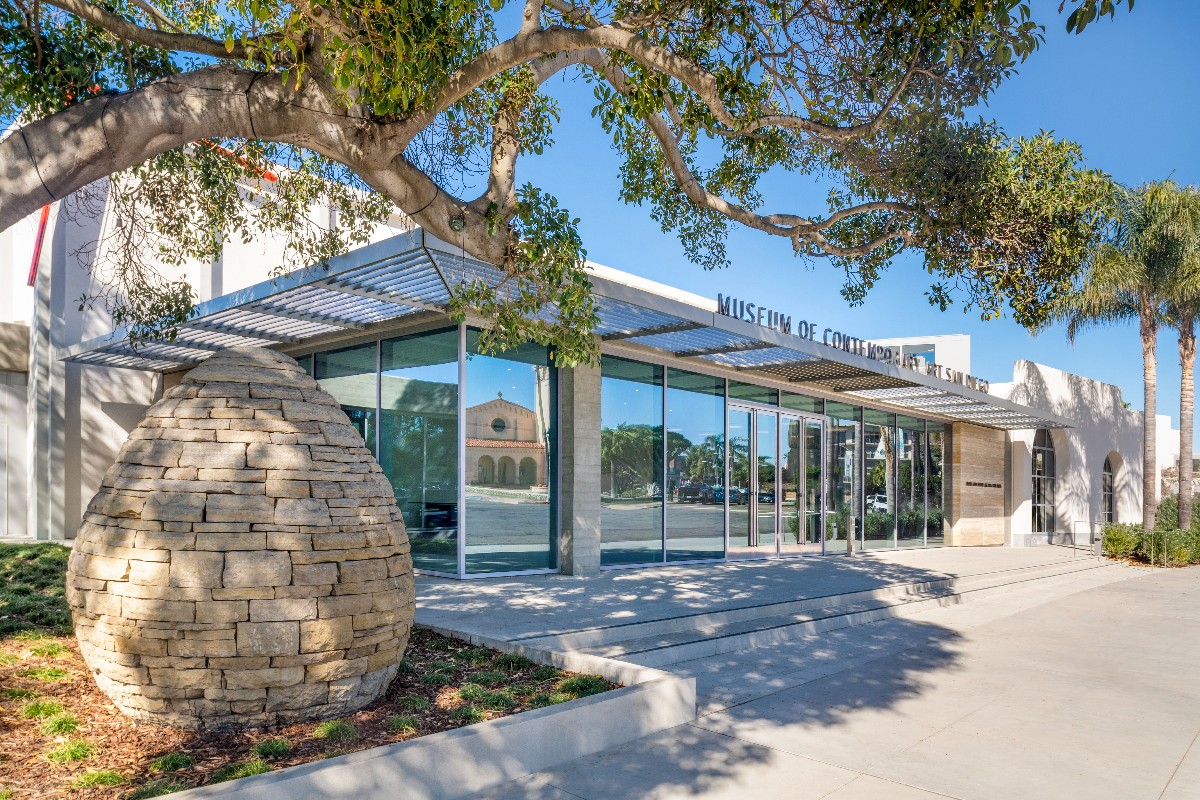MCASD adds ‘hybrid’ works from 3 artists to permanent collection


The Museum of Contemporary Art San Diego (MCASD) has acquired three new artworks that now part of the museum’s permanent collection of over 5,600 unique paintings, sculptures, photographs, videos and installations.
Every year, museum curators arrange an art exhibit that includes potential pieces to acquire, known as the Prospect Initiative.
From those works, the Director’s Circle – a group of art collectors and museum donors – vote on which the museum should purchase.
This year’s newly acquired pieces include Ryan Preciado’s sculpture “Totem (Gene Vincent),” Sarah Rosalena’s weave “Exit Grid” and Bárbara Sánchez-Kane’s hybrid installation “Look 12.”
These newest additions are made out of simple, everyday materials – such as belts, buckles, wood and wool. But they blend categories usually seen as separate to create works that redefine the familiar, according to MCASD Director and CEO Kathryn Kanjo.
With references to fashion, manual labor and technology among other themes, the three “hybrid” pieces stand out for their ability to be “many things at once,” Kanjo added.
“We look to present artists that have an exciting relevance to this moment and to our collection in particular,” Kanjo said.
“The group that we presented this time all shared a sensibility of working across different media, an approach that we see a lot of artists using today that reflects the complexity of our dynamic and messed up world.”
This year’s Prospect Initiative fund enabled the museum to purchase two of the three pieces, while the third was acquired with additional contributions from individual members of the Director’s Circle.
All three new artworks will be on view to the public, alongside the museum’s existing collection, through Nov. 2. Here’s a look at them:
Sarah Rosalena’s “Exit Grid” (2023)

A Los Angeles-based artist and professor of art at UC Santa Barbara, Rosalena, of Wixárika descent (an indigenous group from central Mexico) said she comes from a long line of women weavers.
She’s interested in textiles as a form of ancient technology and said she views weaving as a way to challenge colonial narratives, as well as ideas of what technology can be.
She referenced the lengthy history between weaving and computing, as the Jacquard loom – an early punch card system that pioneered automated pattern creation – inspired the basic binary code used in today’s computers.
“I’m really interested in challenging higher technology, blurring the binary between high and low tech, ancient and future, because so much of that is designed by Western ideology,” Rosalena said.
“Exit Grid” uses wool and cotton yarn to depict the “digital” collapse of borders and boundaries down to the smallest pixel, according to Rosalena.
She used hand-dyed wool to imitate digitally rendered RGB colors and included woven black squares, or glitches, to simulate virtual noise.
Rainbow-colored rows run throughout the piece, unifying the elements and blurring the edges of the computer grid.
Ryan Preciado’s “Totem (Gene Vincent)” (2024)

Preciado said he never set out to become an artist, starting out as a carpenter’s apprentice carving table legs in his hometown.
During the pandemic, he found himself working at a local hardware store, where he developed a close friendship with the owner.
Preciado described how one day he observed the owner stacking faucet handles and was amazed by the artist image it naturally presented.
Inspired by his friend’s dedication to his work, he said he set out to create works that would take ordinary objects seriously and honor the labor of those who create them.
“He never really looked at them as sculptural pieces, but he’s always taken them very seriously and he loves what he does,” Preciado said. “If I could use these objects, maybe I’d give people a chance to look at things the way we were.”
“Totem (Gene Vincent)” is a sculpture made of alder wood, resembling a ceremonial totem, but composed of hardware store faucet handles, which Preciado carved in birch wood and enlarged.
Gene Vincent, whom the piece is partially named after, is a 50’s rock musician that he and the owner both enjoy. The name serves as an homage to his friend.
Bárbara Sánchez-Kane’s “Look 12” (2025)

Sánchez-Kane, an artist based in Mexico City, is well known in both the world of fashion and fine art, with her work appearing across museums and runways.
Raised in a Catholic culture with strict gender norms, she later gained recognition for defying those conventions, earning acclaim for her gender-neutral fashion label, La Casa de Macho Sentimental, which blends masculine and feminine aesthetics.
Sánchez-Kane’s sculptures, consisting of clothing and accessories, depict how clothing functions as a form of self-expression.
One such piece, “Look 12,” brings these themes to life through a woven assembly of belts, items typically used to confine the body.
Freed from their original purpose, the belts now take on new meaning within the artwork.
Tucked into a plume of rawhide rests a pair of black leather high heels, their heels replaced by gold military medallions.
“From this unfurling bloom a new, hybrid form emerges: one both female and male, synthetic and organic, armored and adaptive,” MCASD said in a description of the piece.
Categories
Recent Posts










GET MORE INFORMATION

